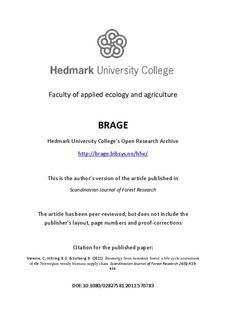Bioenergy from mountain forest: a life cycle assessment of the Norwegian woody biomass supply chain
Journal article, Peer reviewed
Permanent lenke
http://hdl.handle.net/11250/134414Utgivelsesdato
2011Metadata
Vis full innførselSamlinger
Originalversjon
Valente, C., Hillring, B.G. & Solberg, B. (2011). Bioenergy from mountain forest: a life cycle assessment of the Norwegian woody biomass supply chain. Scandinavian Journal of Forest Research 26(5),429-436. 10.1080/02827581.2011.570783Sammendrag
Norwegian mountain forests represent interesting sources of wood biomass for bioenergy. This case study gives a life cycle assessment of the greenhouse gas (GHG) emissions and costs of forest management, harvest and transport operations in the mountainous areas of Hedmark and Oppland counties in Norway. Low-intensity forest management characterizes the study sites. The study shows that transportation to the terminal is the operation with the highest GHG impacts in the examined supply chain and that the bundling of forest residues has the highest financial cost. The mountain forest system analyzed emits 17,600 g CO2e per solid cubic meter over bark. Transportation to the terminal accounts for 31% of the emissions and 23% of the costs, while bundling accounts for 25% of the total emissions and 19% of the total costs. The study shows that there is a considerable quantity of woody biomass available for bioenergy purpose from mountain areas. In the short term, it is possible to integrate harvesting of logging residues in the conventional logging operations. However, it is necessary to improve forest management, logistic and technology for reducing emissions and operative costs, ensuring the achievement of a sustainable system at the same time.
Beskrivelse
This is the postprint version of the article. The published article can be located here: http://www.tandfonline.com/doi/abs/10.1080/02827581.2011.570783
